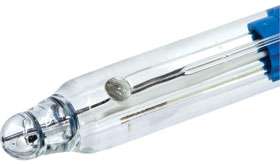

With Endress+Hauser’s Memosens sensors CPS16D, CPS76D and CPS96D, users can determine pH and the redox values with one single sensor. The combined sensors reduce the installation requirements by half for transmitters, assemblies and cables, and also reduce the on-going maintenance requirements for the measuring points. The rH value is also calculated using both measured values from the combination sensors.
The design, specifications and external dimensions of the new sensors do not differ from other pH and redox sensors. Even though several measurement parameters are combined in the combination sensors, they fit in all common assemblies.
First successful applications
The combined Memosens sensor CPS76D is being successfully used in the petrochemical sector, for example in the second stage of flue gas cleaning. In this process, the residual sulphur dioxide (SO2) is oxidised by adding hydrogen peroxide (H2O2) to sulphur trioxide (S03) and is then separated off as sulphuric acid. At the same time, chemically divalent heavy-metal ions are oxidised to become trivalent and are removed by a process of precipitation. In this step of the process, the CPS76D checks the rH value, which must lie between 18 and 28 for an optimal precipitation process.
Another example is the use of the Memosens CPS16D by a large galvanic specialist. There, the sensor monitors the cyanide oxidation with sodium hypochlorite (NaOCl). Due to the combination sensor, it was possible to optimise the process of removing the cyanide. This occurs by setting the pH and redox values at the same time. The heavy-metal ions in the waste water could also therefore be minimised and fewer chemicals are used.
In both cases, the combined pH/redox electrodes make an important contribution to environmental protection. The result is an optimisation of important chemical processes while, at the same time, reducing costs.
Another possible application for the combination sensors is corrosion monitoring using the rH value. If, in addition to the pure redox value, the pH value is also taken into consideration, the rH value represents a pH-independent criterion for the oxidising or reducing behaviour of a solution. This measured value can therefore provide valuable information about the corrosive behaviour of a process.
Measuring the reference resistance
If any medium penetrates the sensors junction and blocks it, this will be detected in good time. This leads to a warning being issued at the transmitter. This new function leads to improved monitoring of the sensors. The measurement of the reference resistance can be used, for example, to trigger automatic cleaning with the Chemoclean Plus function on the CM44 if a customer-defined threshold is exceeded. Predictive maintenance increases the operating time of the sensors.
New Memosens functionalities: due to this new technology, the last eight sensor calibrations are saved. The calibration history can be evaluated and the measuring point can be serviced in good time.
*rH = oxidation-reduction potential under special pH.
For more information contact Jan Swart, Endress+Hauser, +27 (0)11 262 8000, [email protected], www.za.enfress.com

© Technews Publishing (Pty) Ltd | All Rights Reserved